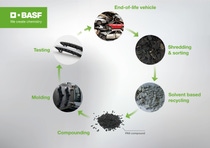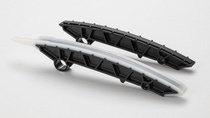Plastics & Rubber
From shredder to guide rail: Solvent-based PA6 recycling
Dirty plastics from automotive shredder residue? We’re revamping it to perform again!
BASF, Mercedes-Benz, and Poeppelmann teamed up to kick-off the next level in physical recycling: revamping the Polyamide 6 (PA6) fraction from the shredder residue of end-of-life vehicles (ASR). Using a special solvent-based recycling process, they turn this material into high-quality plastics that can be used in new car parts. Together the partners have demonstrated that solvent-based recycling can be a complementary recycling technology enabling the production of closed-loop recyclates that deliver high performance in demanding automotive applications. This technology helps to overcome incineration or landfilling of the ASR. Don’t burn it – revamp it!
Re-gaining Polyamide 6 (PA6) from automotive shredder residue
The pilot project tackles one or even the most complex plastic waste streams you can imagine: automotive shredder residue (ASR). The ASR is a wild mix of polluted plastics shred and all kinds of impurities such as sand, glass particles etc. It is the material that remains after entire vehicles have been shredded and the metals have been separated out. Solvent-based recycling can recover target polymers such as PA6 from this material mix via selective dissolution. As the ASR is typically destined for incineration or used as refuse-derived fuel (RDF), this approach offers a promising and environmentally responsible alternative - helping to retain valuable carbon within the material cycle.
The solvent-based recycling process
Through solvent-based recycling, plastics such as Polyamide 6 (PA6) can be selectively dissolved and separated from complex mixtures, enabling the recovery of high-purity polymer material. For the pilot project, automotive-only shredder residue was used as base material, sorted and processed utilizing the solvent-based recycling technology developed by BASF. The selectively dissolved PA6 was purified - removing fillers and impurities from the past lifecycle - before being reprocessed into high-quality plastic granulates. Purification is an advantage that sets solvent-based recycling apart from conventional mechanical recycling methods. Let’s see how we did it.

Step 1: Shred & sorting out of value streams
End-of-life vehicles are shredded and the valuable materials, mainly metals, are sorted out for direct recycling.
Step 2: Sort again
A fraction of different Polyamides is extracted from the shredder residue.
Step 3: Solve it
The extracted Polyamide fraction is sent to a solvolysis step where the PA6 is dissolved and separated.
Step 4: Purify
The PA6 solution is purified to provide the best starting position for the PA6 polymer chains
Step 5: Boost Performance
Finally, glass fibers and additives are added to make the material perform and ready for use.

From right to left: structural part, overmolded part.
Photo: BASF, 2025
Don’t change horses – only adjust your process parameters
The PA6 compound obtained through solvent-based recycling was used to mold a guiding rail for a Mercedes-Benz passenger car. A guiding rail typically supports the timing chain in its movement and thus facilitates controlled movement of the motor unit. Reproducible dimensions of the molded part are therefore not only important for the demolding but also for the parts' function. To validate the process, Pöppelmann manufactured the parts using standard serial production tools and molds, effectively demonstrating that the recycled PA6 material integrates seamlessly with existing manufacturing infrastructure. Only minimal adjustments to the process settings were required. Simultaneously, test specimens were produced at BASF’s pilot center.
The findings? The resulting components underwent detailed analysis, confirming that the recycled material delivers robust, polyamide-like performance. These findings underscore the recyclate’s ability to meet stringent automotive standards - proving it can be used in demanding applications without compromising on mechanical strength, chemical resistance, or overall material integrity.
"The project impressively demonstrates that solvent-based recycling is a practical alternative for plastics that are difficult to recycle mechanically. It makes an important contribution to the holistic circular economy - from the car back into the car,"
To better understand the impact of the recycling process and the materials it produces, a life cycle assessment (LCA) was carried out with support from ETH Zurich’s Energy & Process Systems Engineering Team.
The results are impressive: CO₂ emissions are significantly lower compared to producing conventional fossil-based plastics. Even more impressive — the savings are even greater when compared to burning old car parts, which were instead used as raw material for recycling.
These findings show how advanced recycling can make a real difference in building a circular economy and driving the sustainable transformation of the plastics industry — as long as the right regulations are in place to support it.
Mercedes-Benz is committed to the use of secondary raw materials in its vehicles today and in the future as part of resource conservation and circularity. To continuously increase the availability of such sought-after secondary materials, the expansion of existing and new recycling technologies is essential. Pilot projects along the value chain are of central importance to continuously expand the range of recycling processes used and to gain well-founded insights. This technological diversity is another important step in making our contribution to resource conservation.


